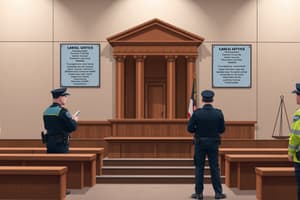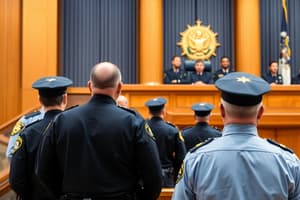Podcast
Questions and Answers
Which court is responsible for reviewing decisions made by lower courts?
Which court is responsible for reviewing decisions made by lower courts?
What is the primary role of law enforcement agencies?
What is the primary role of law enforcement agencies?
Which of the following represents a serious offense classified as a felony?
Which of the following represents a serious offense classified as a felony?
What does the term 'mens rea' refer to in criminal law?
What does the term 'mens rea' refer to in criminal law?
Signup and view all the answers
Which of the following is NOT a key function of law enforcement agencies?
Which of the following is NOT a key function of law enforcement agencies?
Signup and view all the answers
In which phase of court procedures does a defendant enter their plea?
In which phase of court procedures does a defendant enter their plea?
Signup and view all the answers
What is the goal of the corrections system in the criminal justice system?
What is the goal of the corrections system in the criminal justice system?
Signup and view all the answers
Which of the following alternatives to incarceration allows for supervised release?
Which of the following alternatives to incarceration allows for supervised release?
Signup and view all the answers
Study Notes
Criminal Justice System
Law Enforcement
- Definition: Agencies responsible for enforcing laws, maintaining public order, and preventing crime.
-
Key Functions:
- Responding to emergencies and calls for service
- Conducting investigations and gathering evidence
- Arresting suspects
- Patrolling communities to deter crime
-
Types of Agencies:
- Local police departments
- County sheriff's offices
- State police/highway patrol
- Federal agencies (e.g., FBI, DEA)
Court Procedures
-
Court Structure:
- Trial Courts: Handle initial hearings and trials; determine guilt or innocence.
- Appellate Courts: Review decisions made by lower courts; do not conduct new trials.
-
Key Steps:
- Arraignment: Formal reading of charges; defendant enters plea.
- Pre-trial Motions: Requests for court orders; e.g., suppression of evidence.
- Trial: Presentation of evidence and arguments; led by judge/jury.
- Sentencing: If guilty, the judge decides punishment based on laws and guidelines.
Criminal Law
- Definition: Body of law defining offenses and prescribing punishments.
-
Types of Crimes:
- Felonies: Serious offenses (e.g., murder, robbery) with severe penalties.
- Misdemeanors: Less severe offenses (e.g., petty theft) with lighter penalties.
-
Principles:
- Mens Rea: Intent to commit a crime; guilty mind.
- Actus Reus: The actual act of committing the offense; guilty act.
- Due Process: Legal requirement ensuring fair treatment through the judicial system.
Corrections
- Purpose: Manage individuals convicted of crimes; rehabilitate and reintegrate offenders.
-
Types of Corrections:
- Incarceration: Imprisonment in jails or prisons.
- Probation: Supervised release; alternatives to incarceration.
- Parole: Conditional release from prison after serving part of a sentence.
-
Programs:
- Educational and vocational training
- Substance abuse treatment
- Mental health services
Juvenile Justice
- Focus: Legal system addressing offenses committed by minors (typically under 18).
-
Key Differences from Adult Justice:
- Emphasis on Rehabilitation: Focus on treatment, not punishment.
- Confidentiality: Juvenile records are often sealed.
- Court Proceedings: Generally less formal; juvenile courts have different procedures.
-
Types of Offenses:
- Status Offenses: Non-criminal acts that are illegal due to the offender's age (e.g., truancy).
- Delinquent Offenses: Crimes committed by minors that would be crimes if committed by adults.
Law Enforcement
- Agencies enforce laws, maintain public order, and prevent crime.
- Key functions include responding to emergencies, investigating crimes, arresting suspects, and community patrolling to deter criminal activity.
- Types of law enforcement agencies encompass local police departments, county sheriff's offices, state police/highway patrol, and federal entities like the FBI and DEA.
Court Procedures
- Court structure includes trial courts for initial hearings and trials, and appellate courts that review lower court decisions without conducting new trials.
- Key procedural steps are:
- Arraignment: Defendants formally charged and enter their pleas.
- Pre-trial Motions: Legal requests made by parties such as suppression of evidence.
- Trial: Evidence and arguments presented, overseen by a judge or jury.
- Sentencing: Judge determines punishment for the guilty, adhering to statutory laws and guidelines.
Criminal Law
- Body of law delineating offenses and associated penalties.
- Crimes are categorized into:
- Felonies: Serious crimes with severe penalties, e.g., murder and robbery.
- Misdemeanors: Lesser offenses with lighter penalties, e.g., petty theft.
- Key principles include:
- Mens Rea: Criminal intent or guilty mind.
- Actus Reus: The physical act of committing the crime.
- Due Process: Legal mandate for fair treatment within the judicial system.
Corrections
- Aim is to manage convicted individuals, focusing on rehabilitation and reintegration into society.
- Types of correctional measures include:
- Incarceration: Imprisonment in jails or prisons.
- Probation: Supervised community release as an alternative to incarceration.
- Parole: Conditional release from prison post-serving part of a sentence.
- Programs can include educational, vocational training, substance abuse treatment, and mental health services.
Juvenile Justice
- Specialized legal system for minors (typically under 18) addressing criminal offenses.
- Differences from adult justice include:
- Greater emphasis on rehabilitation rather than punitive measures.
- Juvenile records are typically sealed for confidentiality.
- Court proceedings are generally less formal with distinct juvenile procedures.
- Types of offenses include:
- Status Offenses: Non-criminal acts illegal due to age, such as truancy.
- Delinquent Offenses: Crimes committed by minors that would be considered crimes if committed by adults.
Studying That Suits You
Use AI to generate personalized quizzes and flashcards to suit your learning preferences.
Description
Explore the essential components of the criminal justice system, including the roles of law enforcement agencies and the structure of court procedures. Understand the key functions and types of law enforcement, as well as the steps involved in court processes. This quiz covers foundational knowledge critical for students of criminal justice.




